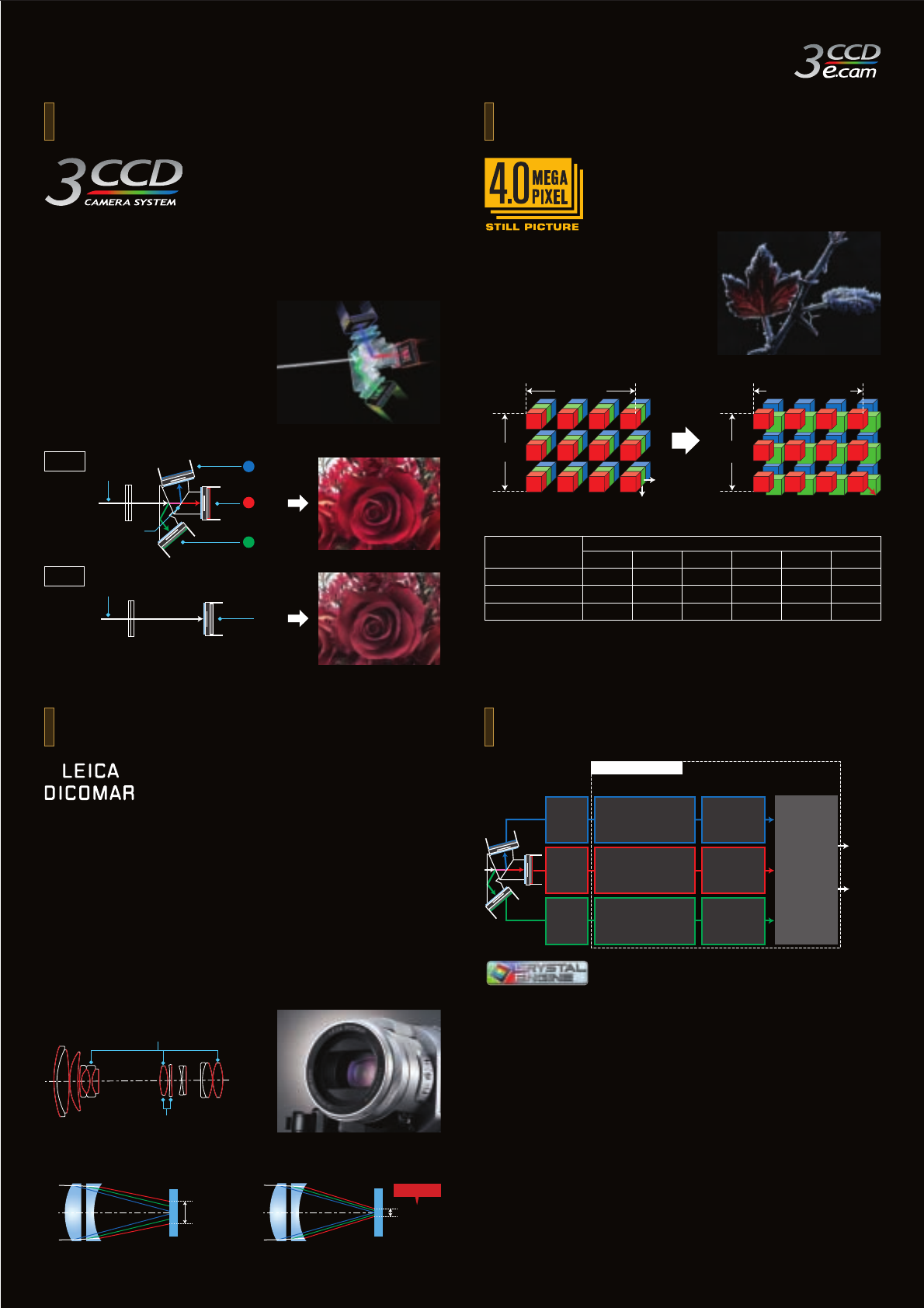
3
GS400
3CCD Camera System
The same system that's used in professional broadcast cameras
Conventional Lens
•
Low Dispersion Glass
•
16 Multi-Coated Lens Surfaces
•
Quad-Density Pixel Distribution Technology
New Lens
Chromatic
Aberration
Chromatic
Aberration
Light Light
Aspherical Lenses
O.I.S. Lenses
Approx. 1/3
LEICA DICOMAR Lens
Superior Leica-certified image quality
4.0-Megapixel Still Picture Recording
You can take breathtaking stills as well
New Crystal Engine
A high-performance image processing
3CCD
1CCD
CCD
CCD
Optical Axis
Optical Axis
Dichroic Mirrors
• The number of recordable pictures will differ if more than one mode (Fine, Normal, Economy)
is used.
• These figures vary depending on the subject being recorded.
* Usable capacity will be less.
Number of Recordable Still Pictures (approx.) 2288 x 1728 pixels
Fine
Normal
Economy
Image Quality
Capacity
512MB
*
265
418
587
1GB
*
512
807
1132
256MB
*
130
206
290
128MB
*
64
102
144
64MB
*
30
49
70
32MB
*
14
23
33
1144 pixels
864 pixels
2288 x 1728 = 4.0 Megapixels
The camera's CCD (charge-coupled device)
plays a critical role in picture quality. That's
why, in the GS400, Panasonic chose a 3CCD
camera system — the type used in
professional video cameras. In this advanced system the incident light is
split into its three primary colour components (red, green and blue), and
the resulting signal from each is collected by one of the three CCDs. The
GS400's 3CCD system features a total of 1,070,000 pixels times 3. It
captures moving pictures with an
effective 690,000 pixels times 3 and still
pictures with an effective 990,000 pixels
times 3, which provides highly detailed
colour information. You can see the
results in the GS400's clear, beautifully
rendered images with fine gradation and
natural, true-to-life colours.
Leica is renowned by photographers everywhere as a
maker of superb cameras and lenses. Now this
legendary optical technology fuses with Panasonic's
advanced digital technology in the Leica Dicomar lens. This brilliant new
lens features 14 lens elements in ten groups and uses low-dispersion
optical glass to reduce chromatic aberration to about 1/3 the level of
conventional lenses. A special multi-coating process is applied to 16 lens
surfaces, minimising harmful reflection to deliver crisp, clear images free
of flare and ghosting. All of the beauty captured by the Leica Dicomar lens
is faithfully translated and recorded by Panasonic's high-performance
3CCD camera system. You can see the results in beautifully rendered
images with the delicate nuances and subtle shading that are Leica
hallmarks. The Leica Dicomar lens also boasts a 12x optical zoom.
*Leica is a registered trademark of Leica Microsystem IR GmbH, and Dicomar is a registered
trademark of Leica Camera AG.
G
CCD
R
CCD
B
Analogue
Signal
Processor
Noise-Shaping Filter
2D RGB Noise Reduction
3D RGB Frame
Noise Reduction
Advanced Pixel
Interpolation
System (AXIS)
Analogue
Signal
Processor
Noise-Shaping Filter
2D RGB Noise Reduction
3D RGB Frame
Noise Reduction
Advanced Pixel
Interpolation
System (AXIS)
Analogue
Signal
Processor
Noise-Shaping Filter
2D RGB Noise Reduction
3D RGB Frame
Noise Reduction
Advanced Pixel
Interpolation
System (AXIS)
Moving-Picture
Circuit
Still-Picture
Circuit
Detail, Contrast
and Colour
CorrectionReduces Noise
Pixel
Interpolation
New Crystal Engine
Moving-
Pictures
Still-
Pictures
Shifted by 1/2 pixel vertically
Shifted by
1/2 pixel
horizontally
2288 pixels (1144 x 2)
1728 pixels
(864 x 2)
New 3D RGB Frame Noise Reduction:
The new noise
reduction system uses a noise-shaping filter (one
dimension) to remove the rough, highly visible noise. Next, it extracts and analyses
data from several adjacent pixels in the horizontal and vertical directions (two
dimension), and removes any parts that it determines to be noise. Finally, the
process is applied to the time axis (three dimension), where it extracts and analyses
several frames, and again removes parts that it determines to be noise. The result
is a better noise-reduction performance than conventional systems provide. The
noise reduction is particularly effective when shooting at low illumination, so you
can capture clear, sharp images even at night or when lights are low.
AXIS (Advanced Pixel Interpolation System): Quad-Density Pixel Distribution
technology improves image precision by interpolating the signal for areas on the
CCD where there are no pixels. AXIS helps reproduce even finely detailed portions
of an image, giving the picture a higher-resolution appearance.
New Digital Signal Processing: This new configuration consists of two separate
image processing circuits, one for moving pictures, one for still pictures. This
makes it possible to record moving pictures and still pictures at the same time,
both with outstanding quality (1.2-megapixel still picture). This advanced digital
system renders clear, sharp, expressive images, with vivid colour and detail down
to individual strands of hair.
The GS400 features Quad-Density Pixel Distribution,
a technology used in Panasonic's professional
equipment. The pixels are shifted a half of intervals
(2.65-micron) both vertically and horizontally within
the tiny 2.65-
micron intervals between them, which
distributes them on the CCD with four
times the density of previous systems.
As a result, the GS400 records 4.0-
megapixel still pictures - highest in the
industry for a compact, home-use digital
video camera.










